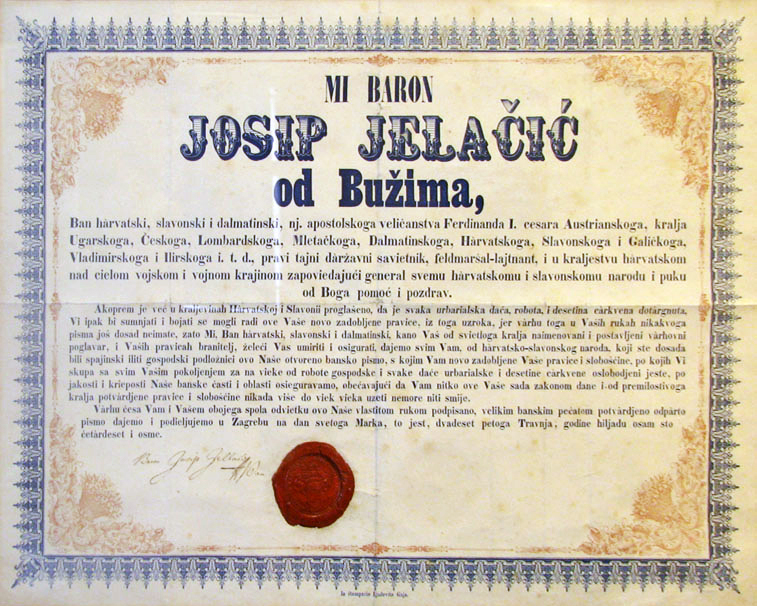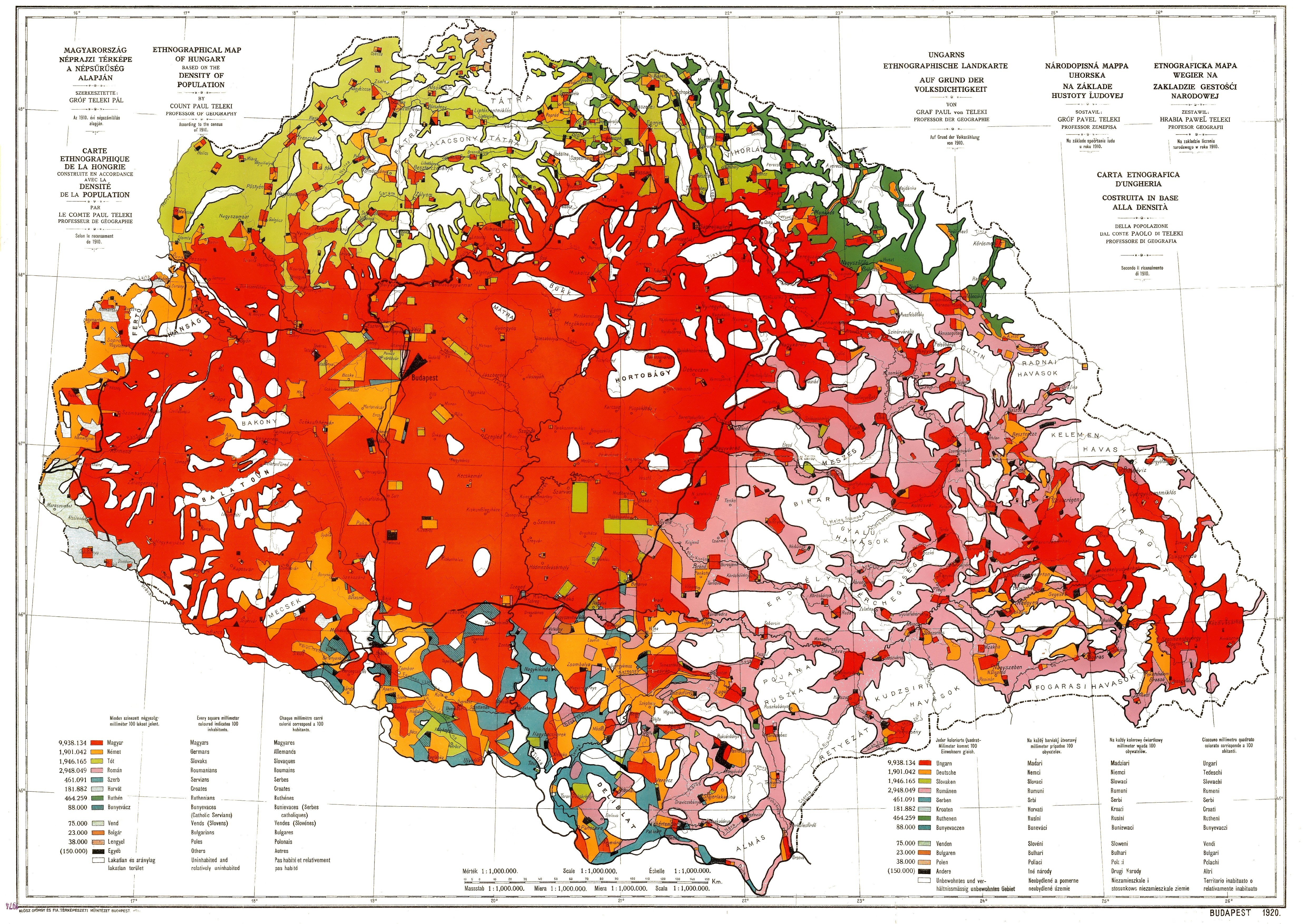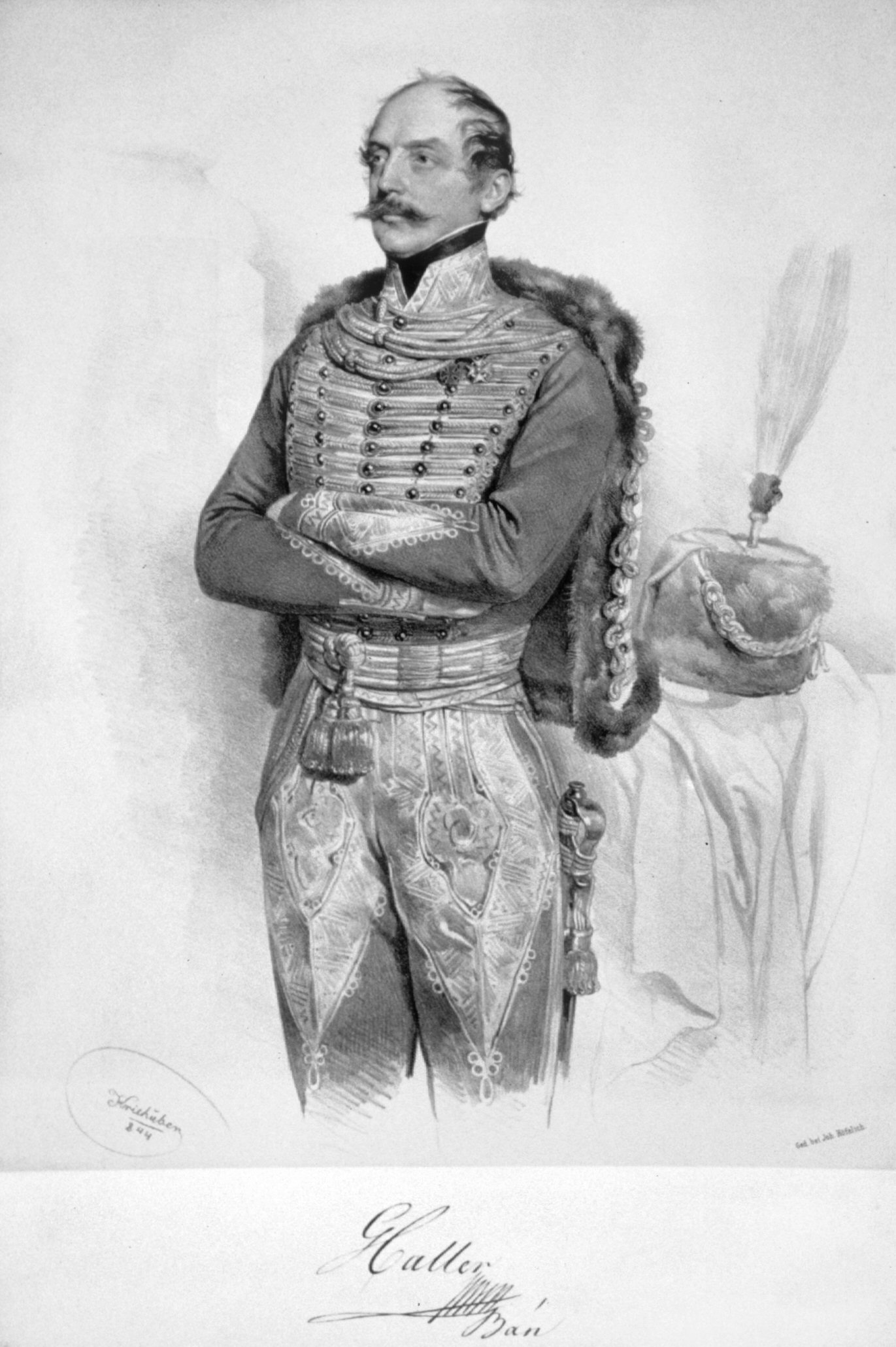|
Juraj Haulik
Juraj Haulik de Váralya ( sk, Juraj Haulík Váralyai, hu, Haulík Váralyai György; 20 April 1788 – 11 May 1869) was a Croatian cardinal in the Roman Catholic Church of Slovak ethnicity and the first archbishop of Zagreb. He was also acting ban of Croatia for two separate terms. Life He studied theology and philosophy in Trnava, Esztergom and Vienna. After the death of bishop Aleksandar Alagović in 1837, Haulik was proclaimed bishop. In 1840 he began his first term as acting ban of Croatia after the death of ban Franjo Vlašić. He is credited for introducing the Croatian language into schools and workplaces, as well as forming the Matica hrvatska in 1842. He helped the organization of Maksimir park in Zagreb. He was succeeded as ban by the Hungarian Franz Haller. Haller was brought in to carry on Magyarization in Croatia, which included the banning of the then Croatian banner name: Illyrians. A protest by the Croatian People's Party in 1845 was put out violently by ... [...More Info...] [...Related Items...] OR: [Wikipedia] [Google] [Baidu] |
Cardinal (Catholicism)
A cardinal ( la, Sanctae Romanae Ecclesiae cardinalis, literally 'cardinal of the Holy Roman Church') is a senior member of the clergy of the Catholic Church. Cardinals are created by the ruling pope and typically hold the title for life. Collectively, they constitute the College of Cardinals. Their most solemn responsibility is to elect a new pope in a conclave, almost always from among themselves (with a few historical exceptions), when the Holy See is vacant. During the period between a pope's death or resignation and the election of his successor, the day-to-day governance of the Holy See is in the hands of the College of Cardinals. The right to participate in a conclave is limited to cardinals who have not reached the age of 80 years by the day the vacancy occurs. In addition, cardinals collectively participate in papal consistories (which generally take place annually), in which matters of importance to the Church are considered and new cardinals may be created. Cardina ... [...More Info...] [...Related Items...] OR: [Wikipedia] [Google] [Baidu] |
Ban (title)
Ban () was a noble title used in several states in Central and Southeastern Europe between the 7th century and the 20th century. The most common examples have been found in Croatia. Sources The first known mention of the title ''ban'' is in the 10th century by Constantine VII Porphyrogenitus, in the work '' De Administrando Imperio'', in the 30th and 31st chapter "Story of the province of Dalmatia" and "Of the Croats and of the country they now dwell in", dedicated to the Croats and the Croatian organisation of their medieval state. In the 30th chapter, describing in Byzantine Greek, how the Croatian state was divided into eleven (; župas), the ban (), (rules over) (Krbava), ( Lika) (and) (Gacka). In the 31st chapter, describing the military and naval force of Croatia, " Miroslav, who ruled for four years, was killed by the () (, i.e. Pribina)", and after that followed a temporary decrease in the military force of the Croatian Kingdom. In 1029, a Latin charter was publ ... [...More Info...] [...Related Items...] OR: [Wikipedia] [Google] [Baidu] |
Josip Jelačić
Count Josip Jelačić von Bužim (16 October 180120 May 1859; also spelled ''Jellachich'', ''Jellačić'' or ''Jellasics''; hr, Josip grof Jelačić Bužimski; hu, Jelasics József) was a Croatian lieutenant field marshal in the Imperial-Royal Army and politician, the Ban of Croatia between 23 March 1848 and 19 April 1859 of Croatian descent. He was a member of the House of Jelačić and a noted army general, remembered for his military campaigns during the Revolutions of 1848 and for his abolition of serfdom in Croatia. Early life and military The son of Croatian baron Franjo Jelačić Bužimski (or in other documents, ) (1746–1810), a lieutenant Field Marshal, and Austrian mother Anna Portner von Höflein, The honorific ''Bužimski'' refers to Bužim, a location in Lika, that was used by the Jelačić family. Jelačić was born in the town of Petrovaradin which was a part of the Slavonian Military Frontier of the Habsburg monarchy and today it is part of Vojvodina ... [...More Info...] [...Related Items...] OR: [Wikipedia] [Google] [Baidu] |
Revolutions Of 1848 In The Habsburg Areas
The Revolutions of 1848 in the Austrian Empire were a set of revolutions that took place in the Austrian Empire from March 1848 to November 1849. Much of the revolutionary activity had a nationalist character: the Empire, ruled from Vienna, included ethnic Germans, Hungarians, Slovenes, Poles, Czechs, Slovaks, Ruthenians (Ukrainians), Romanians, Croats, Venetians and Serbs; all of whom attempted in the course of the revolution to either achieve autonomy, independence, or even hegemony over other nationalities. The nationalist picture was further complicated by the simultaneous events in the German states, which moved toward greater German national unity. Besides these nationalists, liberal and even socialist currents resisted the Empire's longstanding conservatism. Preamble The events of 1848 were the product of mounting social and political tensions after the Congress of Vienna of 1815. During the "pre-March" period, the already conservative Austrian Empire moved further aw ... [...More Info...] [...Related Items...] OR: [Wikipedia] [Google] [Baidu] |
July Victims
The July victims ( hr, Srpanjske žrtve) were members of the Croatian People's Party who fell victim to a crackdown by the Austrian Imperial Army on July 29, 1845. In 1845, there were local elections for the government of Zagreb County, the county containing the capital of Croatia, Zagreb. The Croatian-Hungarian Party candidate won by voter fraud. Upon the announcement of election results, members of the People's Party took to St. Mark's Square to protest the result and accused the winners of vote fraud. The Croatian ban, the ethnic Hungarian Franz Haller called on the Austrian Army to empty the square. When the army moved in to empty the square, one of the protesters, Mirko Bogović, attacked an army officer with a sabre. The army officer was defended by a soldier who fired at Bogović. That led to other soldiers believing an order to fire was issued. The army emptied their bullets into the crowd. In the end, thirteen of the People's Party's protesters were killed and 27 were ... [...More Info...] [...Related Items...] OR: [Wikipedia] [Google] [Baidu] |
Magyarization
Magyarization ( , also ''Hungarization'', ''Hungarianization''; hu, magyarosítás), after "Magyar"—the Hungarian autonym—was an assimilation or acculturation process by which non-Hungarian nationals living in Austro-Hungarian Transleithania adopted the Hungarian national identity and language in the period between the Compromise of 1867 and Austria-Hungary's dissolution in 1918. Magyarization occurred both voluntarily and as a result of social pressure, and was mandated in certain respects by specific government policies. Before the World War I, only three European countries declared ethnic minority rights, and enacted minority-protecting laws: the first was Hungary (1849 and 1868), the second was Austria (1867), and the third was Belgium (1898). In contrast, the legal systems of other pre-WW1 era European countries did not allow the use of European minority languages in primary schools, in cultural institutions, in offices of public administration and at the legal courts ... [...More Info...] [...Related Items...] OR: [Wikipedia] [Google] [Baidu] |
Franz Haller
Ferenc Haller, ''count Haller von Hallerkeö'' (24 March 1796 – 5 March 1875) was a Hungarian politician. He served as ban of Croatia-Slavonia between 1842 and 1845 during the Croatian national revival and the Illyrian movement in the 1830s and 1840s. Haller was born in Kerelőszentpál, Transylvania, as a member of the Hungarian-Transylvanian branch of the Haller von Hallerstein family. He was promoted by emperor Franz Joseph as ban on 16 June 1842 and was later promoted to lieutenant general. He took office on 18 October. Haller was brought in to carry on Magyarization in Croatia. In 1843, the use of the Illyrian name was banned. In large part due to the July victims incident, in which thirteen protesters were killed in Zagreb, Haller resigned his post and continued his military career in the Austrian Empire. Bishop Juraj Haulik became ban soon after. In 1845 Haller donated 500 forint for building the Croatian National Theatre in Zagreb Zagreb ( , , , ) is the capita ... [...More Info...] [...Related Items...] OR: [Wikipedia] [Google] [Baidu] |
Hungarian People
Hungarians, also known as Magyars ( ; hu, magyarok ), are a nation and ethnic group native to Hungary () and Kingdom of Hungary, historical Hungarian lands who share a common Hungarian culture, culture, Hungarian history, history, Magyar tribes, ancestry, and Hungarian language, language. The Hungarian language belongs to the Uralic languages, Uralic language family. There are an estimated 15 million ethnic Hungarians and their descendants worldwide, of whom 9.6 million live in today's Hungary. About 2–3 million Hungarians live in areas that were part of the Kingdom of Hungary before the Treaty of Trianon in 1920 and are now parts of Hungary's seven neighbouring countries, Hungarians in Slovakia, Slovakia, Hungarians in Ukraine, Ukraine, Hungarians in Romania, Romania, Hungarians in Serbia, Serbia, Hungarians of Croatia, Croatia, Prekmurje, Slovenia, and Hungarians in Austria, Austria. Hungarian diaspora, Significant groups of people with Hungarian ancestry live in various oth ... [...More Info...] [...Related Items...] OR: [Wikipedia] [Google] [Baidu] |
Maksimir
Maksimir () is one of the districts of Zagreb, Croatia, population 48,902 (2011 census). Maksimir stadium and Maksimir Park are located in it. It was named for Bishop Maksimilijan Vrhovac. The urban center of the Maksimir district is located around the Maksimirska street, which is an area of dense commercial and residential usage. It spans from the Kvaternik Square, located on the southwestern border of the district, to the intersection of Maksimirska, Bukovačka and Svetice streets, which leads to the entrances to both the Maksimir park and the Maksimir stadium. The southeastern part of the district is a lowland that includes the Maksimir stadium and a large residential area best known as Ravnice (lit. "plains"). A substantial area in the east of the district is part of the Maksimir Park, one of the biggest parks in Zagreb. It also contains the Zagreb Zoo, which is the second-largest in Croatia; and five lakes, called the Maksimir lakes. The central part of the district is mostl ... [...More Info...] [...Related Items...] OR: [Wikipedia] [Google] [Baidu] |
Matica Hrvatska
Matica hrvatska ( la, Matrix Croatica) is the oldest independent, non-profit and non-governmental Croatian national institution. It was founded on February 2, 1842 by the Croatian Count Janko Drašković and other prominent members of the Illyrian movement during the Croatian National Revival (1835–1874). Its main goals are to promote Croatian national and cultural identity in the fields of art, science, spiritual creativity, economy and public life as well as to care for social development of Croatia. Today, in the Palace of Matica hrvatska in the centre of Zagreb more than hundred book presentations, scientific symposia, round table discussions, professional and scientific lectures and concerts of classical music are being organized annually. Matica Hrvatska is also one of the largest and most important book and magazine publishers in Croatia. Magazines issued by Matica are ''Vijenac'', ''Hrvatska revija'' and ''Kolo''. Matica Hrvatska also publishes many books in one of its ... [...More Info...] [...Related Items...] OR: [Wikipedia] [Google] [Baidu] |
Croatian Language
Croatian (; ' ) is the standardized variety of the Serbo-Croatian pluricentric language used by Croats, principally in Croatia, Bosnia and Herzegovina, the Serbian province of Vojvodina, and other neighboring countries. It is the official and literary standard of Croatia and one of the official languages of the European Union. Croatian is also one of the official languages of Bosnia and Herzegovina and a recognized minority language in Serbia and neighboring countries. Standard Croatian is based on the most widespread dialect of Serbo-Croatian, Shtokavian, more specifically on Eastern Herzegovinian, which is also the basis of Standard Serbian, Bosnian, and Montenegrin. In the mid-18th century, the first attempts to provide a Croatian literary standard began on the basis of the Neo-Shtokavian dialect that served as a supraregional ''lingua franca'' pushing back regional Chakavian, Kajkavian, and Shtokavian vernaculars. The decisive role was played by Croatian Vukovians, ... [...More Info...] [...Related Items...] OR: [Wikipedia] [Google] [Baidu] |
Franjo Vlašić
Franjo baron Vlašić (Austrian: Franz Vlassits; Hungarian: Vlassich Ferenc; 24 April 1766 – 16 May 1840) was a Croatian general and ban of Croatia between 1832 and 1840. In 1784 he began his military career. Vlašić obtained the rank of general in 1813. In 1831 he was appointed as military commander in Petrovaradin. Serbs in Petrovaradin considered General Vlašić one of their own. He became a ban on 10 February 1832. He resisted the Magyarization of Croatia, especially the teaching of Hungarian in schools. During his rule the Croatian national revival began with the Illyrian Movement. Following his death, he was succeeded by Juraj Haulik as acting ban. See also * Martin von Dedovich * Anton Csorich * Adam Bajalics von Bajahaza * Andreas Karaczay * Paul Davidovich Baron Paul Davidovich or Pavle Davidović ( sr-cyr, Павле Давидовић) (1737, Buda – 18 February 1814, Komárom) became a general of the Austrian Empire and a Knight of the Military ... [...More Info...] [...Related Items...] OR: [Wikipedia] [Google] [Baidu] |


.jpg)



